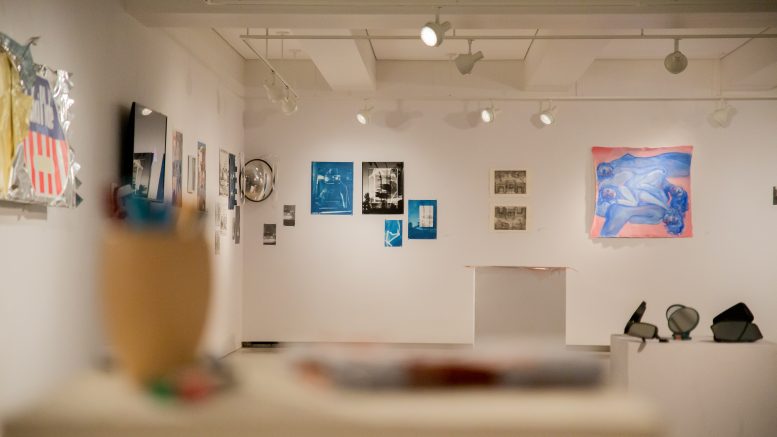The School of Art Student Gallery at the Taché Arts Complex hosted an art exhibit titled Re: Collecting: Memories From The Rear View Mirror, featuring artists Sharyn Gutierrez, Herlinda Dalayoan, and Brian Guevarra from Nov. 22 to 29.
The exhibition featured an array of multimedia artworks that ranged from silkscreen to digital prints, traditional paintings and illustrations, and even a Filipino karaoke video, complete with lyrics to sing along to mounted on one of two television sets at the back of the gallery.
The theme was first developed through one of Guevarra’s pieces titled “Follow and Return,” which features the concept of a person stuck between two stages of their life. More specifically, between childhood and adulthood.
The piece represents “this idea of looking forward to look backwards,” said Guevarra. “Or, looking at a memory as if you are looking toward the future.”
Gutierrez said that although the three artists have been friends for a long time, they only started working on their art together during the summer.
It was during this time that they realized they had a lot of shared experiences, whether that be through their culture, the way they process things that have happened in their lives or their stages in life.
“I really do feel that it is a show about Filipino diaspora perspectives,” Dalayoan said.
“But also, [it] has grown to be more than that,” she said.
She said reflection and processing oneself in the present when there was no chance in the past is a recurring theme.
These shared feelings are why they wanted to work on the exhibit together.
However, finding the time to get together to work on their exhibit proved difficult for the trio, each of whom are students at the school of art.
The three agreed that it was a very busy time for them with the art exhibit, schoolwork and other commitments, but Gutierrez said “it was very rewarding.”
On opening night, the show hosted a reception for visitors that was well-received by guests, which included an assortment of Filipino foods.
Before the positive response, Guevarra said he was initially nervous about how not only the food, but the presentation of the art would be received, because of its “unconventional way of installing things.”
The artists employed many features not commonly used in the gallery space, such as poster poles and showcased artworks that wouldn’t necessarily be associated with “high class” or “elitist” art, like a guest book that visitors could add messages or their own doodles to.
Guevarra said it was important for the group to showcase their work in a school setting, as it means to challenge the perceived standard of “institutionalized” or “fine” art.
“It’s a very colonial and western and Eurocentric standard of what ‘good art’ or what ‘art that deserves to be displayed’ should be,” Guevarra said.
Initial fears about how the exhibition would be received were quelled by the amount of stickers that the group had printed for the show and how little food they had left by the end of their reception. The appreciation for the space was clear.
While Dalayoan said she wasn’t sure how the show would come together at first given the artists’ different styles, her apprehension disappeared during the final stretch of setting up.
“It was only in the final hours of setting things up that I really, truly [saw] how harmonious everything was, and it was really beautiful to witness that.”


